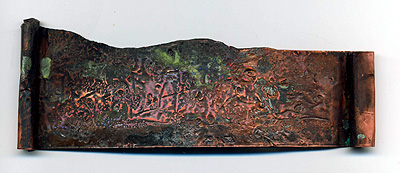
The Zymoglyphic Museum has added a significant new collection to its Rust Age holdings - a set of copper scrolls depicting the mythical Primordial Ooze. During the Rust Age, most artifacts were constructed using naturally weathered materials, whether rusty metal or partially decayed organic matter. However, there were attempts by early Zymoglyphic alchemists to reproduce these effects artificially, a collaboration of art and nature (following, as always, the dictum "Let nature do the detail work").
European alchemists had a goal to transform base metals, such as copper, which were subject to corruption through natural oxidation, into pure gold, which was incorruptible and did not tarnish or weather. Zymoglyphic alchemists were more interested in maximizing the corruption of the base metal; purity was seen a sort of bland homogeneity. The Zymoglyphic ideal was to transform something relatively pure, such as a sheet of copper, into something more complex and interesting. Alchemists in both cultures sought to release "spirit in matter" through the symbolic dissolution of metal and creation of its fermentation byproducts.
Zymoglyphic alchemists used many of the same chemicals on their copper that their European counterparts used to transform metal - blue vitriol (copper sulfate), sal ammoniac (ammonium chloride), liver of sulfur, and common salt, as well as biologically derived fluids such as vinegar and urine. By applying this process to scrolls of sheet copper, they produced pre-literate "books" that told the story of the creative ferment in the primordial ooze. During the Zymoglyphic Age of Wonder, alchemists focused more on metaphysical transformations, rather than chemical ones, as can be seen in this alchemical apparatus from that era.
Copper has been valued throughout Zymoglyphic history. It is one of the very few metals besides gold (and iron meteorites) to be found naturally in pure metallic form. Copper ores can be very attractive, particularly green malachite and and its brilliant blue relative, azurite. Both are chemically closely related to copper patina, or verdigris. The museum has a particularly nice specimen of malachite which was mounted as a viewing stone during the Era of Oriental Influence. A mineral specimen containing both malachite and azurite was incorporated into the Age of Wonder's small cabinet of wonders, and a complex nodule of metallic copper is on display as a miniature sculpture in one of the Modern Era's shoebox art galleries.
Some further references on historical alchemy:
The Golden Game: Alchemical Engravings of the Seventeenth Century
Alchemy & Mysticism: The Hermetic Museum (Klotz)
Psychology and Alchemy
The Forge and the Crucible: The Origins and Structure of Alchemy
The Alchemy Web Site
For pictures of copper ores, see Molly Holzschlag's Mineral Art Flickr set
1 comment:
Good article, you make some interesting points. I learn more about The Zymoglyphic Museum .
museum directory
Post a Comment